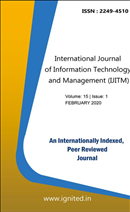Economics In India: A Look at Saving and Investing Patterns
Main Article Content
Authors
Abstract
India's economy has strong saving investment rates, a large population, and increasingintegration with the global economy, all of which bode well for its long-term growth prospects. To invest isto transform cash or money into an asset or a claim on future money with the expectation of a return. Itentails investing one's savings or accumulated capital into the production of new assets or the purchase ofpreexisting ones. In the current financial market, investment has become complicated and it is both an artand a science. The variables that measure the growth of any economy are income, savings, andinvestments. While investment is the most critical factor for developing an economy, savings provide thebasis for investment. The researcher is interested in studying saving and investment trends of individualand investment schemes selected by investors.
Downloads
Download data is not yet available.
Article Details
Section
Articles
References
- Akula, R., & Reddy, M. (2017). An Overview of Mutual Funds in India. International Education and Research Journal, 3(5).
- Alexander Gordon J, Sharpe William F & Bailey Jeffery V. (2003) Fundamentals of Investments, Pearson Education, New Delhi-01
- All On Money. (2016, November 17). Zero Risk, High Return Investments for Low Income Earners in India. Retrieved from All On Money: https://www.allonmoney.com/investments/poor-income-earners/
- Alvarez-Cuadrado, F., & Van Long, N. (2008). A permanent income version of the relative income hypothesis.
- Amudha, J., & Varathan, V. A. (2015). Savings and investment behavior of rural household in salem. International Journal of Multidisciplinary Research and Development, 2(5), 128-33.
- Amudhan, S., Poornima, J., & Senthilkumar. (2016). A Study on Individual Investors Satisfaction Level of Existing Investment Schemes in Salem Districts. International Journal of Advance Research and Innovative Ideas in Education, 2, 1239-1245.
- Anand, S. (2011, March 28). Warren Buffet's Investing Tips in India. Retrieved from The Wall Street Journal: https://www.wsj.com/articles/SB100014240527487044719045762280506 45442860
- Ariga, K., Hill, J., & Ji, Q. (2007). Layer-by-layer assembly as a versatile bottomup nanofabrication technique for exploratory research and realistic application. Physical Chemistry Chemical Physics, 9(19), 2319-2340.
- Arti, G., Julee, & Sunita, S. (2011). Difference in Gender Attitude in Investment Decision Making in India. Research Journal of Finance, and Accounting, 2, 1-6.
- Ashwinprabha, V., & Pandian, P. (2016). Interrelationship between Investment Behavior and Financial Literacy: A study with specific reference to Married Women in Pollachi Taluk. International Journal of Advance Research in Computer Science and Management Studies, 4(6), 293-299.
- Athukorala, P. C., & Sen, K. (2004). The determinants of private saving in India. World Development, 32(3), 491-503.
- Athukorala, P. C., & Sen, K. (2004). The determinants of private saving in India. World Development, 32(3), 491-503.
- Athukorala, P. C., & Tsai, P. L. (2003). Determinants of household saving in Taiwan: Growth, demography and public policy. The Journal of Development Studies, 39(5), 65-88.
- Athukorala, P., (1998) ―Interest rate, saving and investment: Evidence from India‖, Oxford Development Studies, 26(2).
- Avadhani V,A, (1997) Securities Analysis and Portfolio Management Himalaya Publishing House, Delhi-2
- Avadhani, V. A. (1992). Investment and securities markets in India: investment management. Himalaya Pub. House.
- Awais, M., Laber, F., Rasheed, N., & Khursheed, A. (2016). Impact of Financial Literacy and Investment Experience on Risk Tolerance and Investment Decisions: Empirical Evidence from Pakistan. International Journal of Economics and Finance, 6, 73-79.
- Babbie, E. R. (2008). The basics of social research. USA: Cengage Learning.
- Baddeley, M. (2017). Investment: Theories and Analyses. Macmillan International Higher Education.
- Baddeley, M.C, (2003), Investment Theory and Analysis, Palgrave Macmillan, New York.
- Bandarchuk, P., & Hilscher, J. (2012). Sources of momentum profits: Evidence on the irrelevance of characteristics. Review of Finance, 17(2), 809-845
- Ghodake, S. P., & Khedkar, E. B. (2020). A study of the savings and investment pattern of rural household with special reference to Nashik district: A pilot study. Vidyabharati International Interdisciplinary Research Journal, 11(1), 73-83.
- Kandpal, V., & Mehrotra, R. (2018). Role of Behavioral Finance in Investment Decision–A Study of Investment Behavior in India. International Journal of Management Studies, 4(6), 39.
- Lokhande, M. A. (2015). A study of investment awareness and patterns of savings and investments by rural investors. Indian journal of finance, 9(7), 22-31.
- Sadavarte, B., & Arora, A. (2019). A Study on “Saving and Investment Pattern of Indian Households”. Chetana’s, 1.
- Saikia, S. (2018). Investment Pattern of Youth in India with particular reference to Mumbai.

